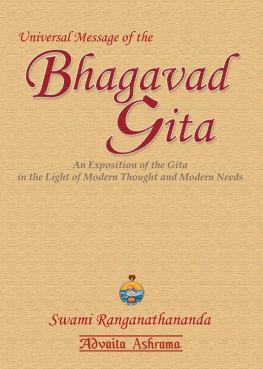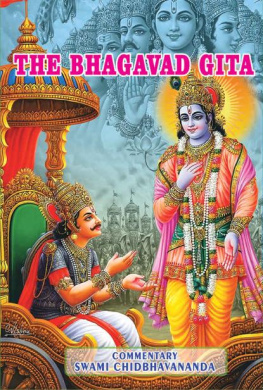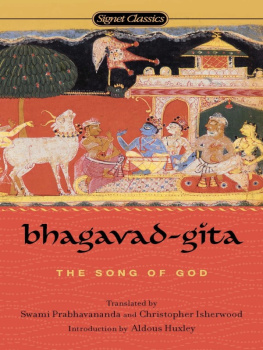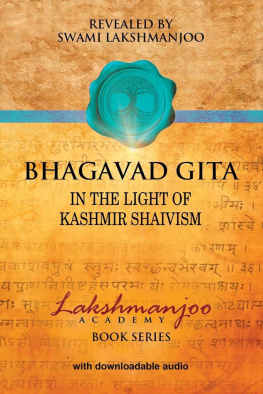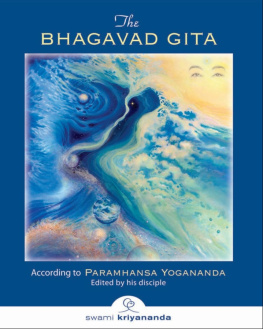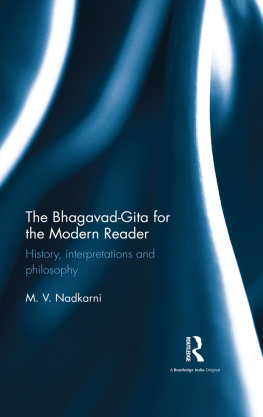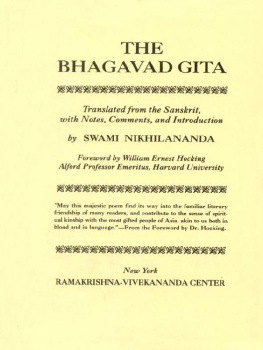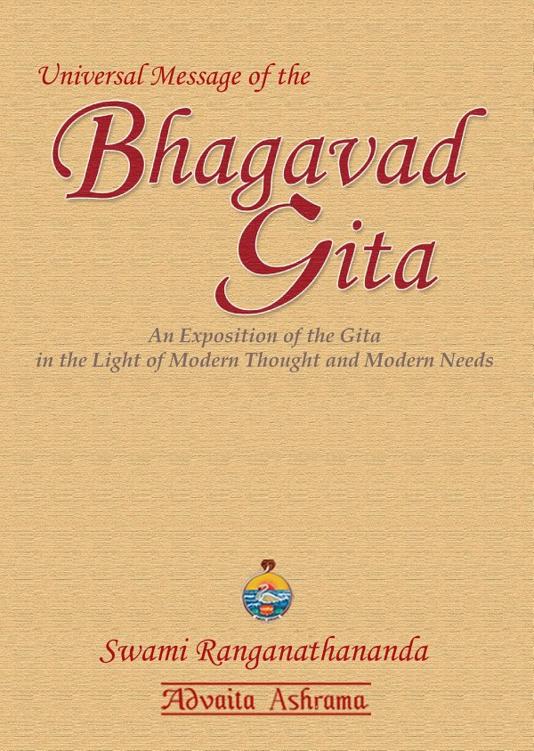Published by
The Adhyaksha
Advaita Ashrama
P.O. Mayavati, Dt. Champawat
Uttarakhand - 262524, India
from its Publication Department, Kolkata
Email: mail@advaitaashrama.org
Website: www.advaitaashrama.org
All Rights Reserved
First Print Edition, July 2000
First Ebook Edition, February 2020
ISBN 978-81-7505-236-9 (Hardbound)
ISBN 978-81-7505-933-7 (Ebook)
P UBLISHERS P REFACE
We are happy to present before our readers the first volume of a three-volume work, Universal Message of the Bhagavad Gt a verse by verse exposition of the Gt by Swami Ranganathanandaji, President of Ramakrishna Math and Ramakrishna Mission. This commentary was originally given as a series of Sunday discourses, from 1988 to 1990, at the 1200-capacity Vivekananda Hall of the Ramakrishna Math, Hyderabad, and it regularly drew an overflow audience consisting of a cross-section of the city population, including many youths.
These lectures, delivered extempore, were recorded, and the audio and video cassettes have reached many homes in various parts of India and abroad. The nature of the subject as well as its treatment by the speaker and his method of delivery, invariably held the attention and sustained the interest and enthusiasm of a large and varied audience. Packed with many stimulating and delightfully refreshing ideas, and drawing upon the works of eminent national and international poets, scientists, authors, and historians, this commentary explains the universal and humanistic teachings of The Song Celestial , as Edwin Arnold called the Gt , in the context of modern thought and modern needs. Thus it is bound to keep the readers absorbed from beginning to end. This three-volume work on the Gt also makes a wonderful companion to the Swamis Message of the Upaniads , published by Bharatiya Vidya Bhavan, Mumbai, now in its seventh edition, which contains an appendix of the Swamis correspondence with the biologist, the late Sir Julian Huxley, on the book.
In transcribing the lectures from the audio cassettes, we have received substantial help from Swami Satyapriyananda of the Ramakrishna Mission, as well as Sanskrit scholar and Vedanta Student, Miss Dana Sugu of Romania whose translations of several Upaniads into Romanian have been published in Bucharest. These lectures on the Gt were thoroughly edited by Swami Ranganathanandaji with the help of Swami Satyapriyananda, Brahmachari Saswatachaitanya, and Swami Nischalananda. As Swami Ranganathanandaji is 91 and is in frail health, without their devoted help, the author says, this work could not have come out.
Volume one presents the first four chapters of the Gt . Every effort will be made by Swami Ranganathanandaji and the Publishers, to bring out the second and third volumes expounding the remaining fourteen chapters, in due course.
Publisher
Guru Purnima
16 July 2000
Hints on Transliteration and Pronunciation
In the book, Devangar characters are transliterated according to the scheme adopted by the International Congress of Orientalists at Athens in 1912 and since then generally acknowledged to be the only rational and satisfactory one. In it the inconsistency, irregularity, and redundancy of English spelling are ruled out: f, q, w, x, and z are not called to use; one fixed value is given to each letter. According to this scheme
Sounds like
a
o in s o n
a in m a ster
i
i in i f
ee
in f ee l
u
u in f u ll
oo in b oo t
somewhat between
r and ri
e
a in ev a d
ai
y in m y
o
o in o ver
au
ow in n o w
k
k
kh
ckh in blo ckh ead
g
g (hard)
gh
gh in log- h ut
ng
c
ch (not k)
ch
chh in cat ch him
j
j
jh
dgeh in he dgeh og
n (somewhat)
t
h
th in an t-h ill
d
h
dh in go dh ood
n
n in u n der
t
French t
th
th in th umb
d
d in th em
dh
theh in brea the here
n
n
p
p
ph
ph in loo p-h ole
b
b
bh
bh in a bh or
m
m
y
r
r
l
l
v
v in a v ert
sh
sh in sh ow
s
s
h
h
.
m in hu m
:
half h in hu h !
The following points may also be noted:
(1) All Sanskrit words, except when they are proper nouns, or have come into common use in English, or represent a class of literature, cult, sect, or school of thought, are italicized.
(2) Anglicized Sanskrit words like krmic, samsric, Arhathood, etc., are romanized.
(3) Current geographical names, except in cases where their Sanskrit forms are given, or in special cases where the context requires it, and all modern names from the commencement of the nineteenth century are given in their usual spelling and without diacritical marks.
INTRODUCTION
T HE C HARM A ND P OWER O F T HE G T
We shall begin with a ntipha or Peace Chant of the Upaniads:
Om Sahanvavatu; sahanaubhunaktu;
Sahavryam karavvahai;
Tejasvinvadhtamastu;
M vidvivahai;
Om nti, nti, nti
Om, May God protect us (teacher and students) together. May we be nourished together. May we attain vigour together. May we become illumined by this study. May we not hate each other. Om, peace, peace, peace.
P REFATORY R EMARKS : I NDIAS E RSTWHILE M ISUNDERSTANDING OF THE G T
We shall commence the study of the Bhagavad Gt this evening. The first three chapters convey the central theme of the philosophy and spirituality of Yoga, which r Ka refers to at the beginning of the fourth chapter. That philosophy is enriched in the remaining fourteen chapters. But the core of his original message has been expounded in chapters two and three. It is a book that is meant to be a help to realize the eternal spiritual reality within all men and women, along with the humanistic objectives which we have in our Constitution and also those which humanity is seeking in the modern age. That is why this Gt message is spreading now in various parts of the world. So far as we are concerned, we have to approach this study in this modern period from a point of view different from our traditional way. In the past, people mostly read the Gt as a pious act, and for a little peace of mind. We never realized that this is a book of intense practicality, that this is the greatest book of practical Vedanta capable of helping us to create a society of fully developed human beings. We never understood the practical application of the Gt teachings. If we had done so, we would not have had the thousand years of foreign invasions, internal caste conflicts, feudal oppressions, and mass poverty. We never took the Gt seriously; but now we have to. We need a philosophy that can help us to build a new welfare society, based on human dignity, freedom, and equality. That is what we have set before ourselves in modern India, and that is also what is inspiring all the people of the world; and here in the Gt is a philosophy that will train peoples minds and hearts in that direction. This orientation, a practical orientation, was given to the Gt for the first time in the modern age by Swami Vivekananda. r Ka gave it several thousand years ago as a practical philosophy, but we converted it into a mere book of piety. When we read the Gt Dhyna lokas those remarkable verses on The Meditation Verses on the Gt, we will find this idea there. The Gt is compared to the milk taken out of the cow, meaning the Vedas, by r Ka, the milkman. What is the milk for? It is not meant for worship, but it is meant to be drunk for our nourishment. Then alone can one get strength. But all these hundreds of years, we took that glass of milk, worshipped it with flowers, and saluted it, but never drank it. That is why we are feeble, physically, mentally, and socially. That will change if we now start drinking this milk and assimilate it. That will help us to develop character strength, work efficiency, and a spirit of service, and to forge a new national destiny.

